Airborne Microplastics: Source Implications from Particulate Matter Composition
Abstract
1. Introduction
2. Materials and Methods
2.1. Sample Collection
2.1.1. Sampling Sites and Attributes
2.1.2. Sampling Methods
2.2. AMPs Sample Preparation and Identification
2.2.1. Preparation for AMPs Samples
2.2.2. Identification of AMPs
- C: The number concentration of AMPs [MPs m−3];
- n: The number of AMPs identified [MPs];
- Sf: The effective filtration area (= φ4 mm) [m2];
- V: The total air suction amount (converted to 20 °C) [m3];
- Sr: The area of a field of view of μRaman (=140 μm × 110 μm) [m2];
- N: The number of fields of view of μRaman measured (=30).
| Items | Conditions/Settings |
|---|---|
| measurement mode | single point measurement |
| visual field image mode | mixture of dark/bright |
| range of targeted wavenumbers | 500−3600 cm−1 |
| accumulation count | 3−5 times |
| exposure time | 5−10 s/time |
| excitation wavelength | 532 nm (green) |
| maximum laser power | 50 mW |
| laser power output | 1−5% of the maximum |
| slit type | φ100 μm, φ34 μm, φ17 μm |
| grating type | 900 line/mm |
2.3. PM Samples Preparation and Analysis
2.4. Data Analysis
2.4.1. Simple Pearson Regression Analysis
2.4.2. Back-Trajectory Clustering
3. Results and Discussion
3.1. Comparative Overview of AMPs and Major PM Components
3.2. Composition, Size, and Morphology of AMPs
3.2.1. Polymer Composition of AMPs
3.2.2. Feret Diameter Distribution and Morphological Classification of AMPs
3.3. Exploratory Analysis of Potential Sources via Simple Regression
3.4. Back-Trajectory Clustering and Its Implication for AMP Transport
- Cluster No. 1: Air masses flowing into Japan from the southeast, circling around the periphery of Pacific high.
- Cluster No. 2: Air masses flowing into Japan from the north to northwest via Primorsky Krai in Russia.
- Cluster No. 3: Air masses flowing into Japan from the northwest via Siberia and northeastern China.
- Cluster No. 4: Air masses, located slightly south of Cluster No.3, flowing into Japan via Siberia, Mongolia, northeastern China, the Korean Peninsula.
4. Conclusions
Author Contributions
Funding
Institutional Review Board Statement
Informed Consent Statement
Data Availability Statement
Acknowledgments
Conflicts of Interest
Appendix A
Appendix A.1. Supporting Tables
| Site/Attribute | Characteristics |
|---|---|
| Kawasaki (urban) |
|
| Niigata-sowa (semi-urban) |
|
| Kasahori Dam (rural) |
|
| Components | Acronyms | Components | Acronyms | Components | Acronyms |
|---|---|---|---|---|---|
| ions | organics | ||||
| chloride | Cl− | ammonium | NH4+ | malonic acid | MA |
| nitrate | NO3− | potassium | K+ | succinic acid | SCA |
| sulfate | SO42− | magnesium | Mg2+ | glutaric acid | GA |
| sodium | Na+ | calcium | Ca2+ | adipic acid | AA |
| 2,3-dihydroxy-4-oxopentanoic acid | DHOPA | ||||
| inorganic elements | pinonic acid | PNA | |||
| aluminum | Al | selenium | Se | vanillin | VLN |
| titanium | Ti | rubidium | Rb | pimelic acid | PMA |
| vanadium | V | cadmium | Cd | 4-hydroxybenzoic acid | 4-HBA |
| chromium | Cr | antimony | Sb | mannosan | MAN |
| manganese | Mn | cesium | Cs | phthalic acid | PTA |
| iron | Fe | barium | Ba | syringaldehyde | SYAL |
| cobalt | Co | lanthanum | La | suberic acid | SBA |
| nickel | Ni | cerium | Ce | levoglucosan | LEV |
| copper | Cu | samarium | Sm | vanillic acid | VA |
| zinc | Zn | tungsten | W | isophthalic acid | PIA |
| arsenic | As | lead | Pb | terephthalic acid | TPA |
| Azelaic acid | AZA | ||||
| Cholesterol | CHOL | ||||
| Items | Conditions/Settings |
|---|---|
| GC | |
| Capillary column | InertCap 5MS/Sil (30 m, 0.25 mm I.D., 0.25 µm f.t.) |
| Injection mode | Splitless |
| Injection volume | 1 µL |
| Injection temperature | 270 °C |
| Oven temperature | 80 °C (3 min)-3 °C/min-200 °C (2 min)-15 °C/min-300 °C (15 min) |
| Carrier gas | He(1 mL/min) |
| MS | |
| Interface temperature | 270 °C |
| Ion source temperature | 230 °C |
| Ionization | EI |
| Detection mode | SIM |
| Acronyms | Polymer Names |
|---|---|
| PE | Polyethylene |
| PET | Polyethylene terephthalate |
| PA | Polyamide |
| PS | Polystyrene |
| PHB | Polyhydroxybutyrate |
| RES | Plastic resin (i.e., Epoxy resin, Phenoxy resin) |
| EVA | Ethylene-vinyl acetate |
| PVA | Polyvinyl alcohol |
| PP | Polypropylene |
| PUR | Polyurethane |
| PEster | Polyester (excluding PET) |
| PE/PP | Copolymer of Polyethylene/Polypropylene |
| PPS | Polyphenylene sulfide |
| PS/PVC | Copolymer of Polystyrene/Polyvinyl chloride |
| PMMA | Polymethyl methacrylate |
| PVC | Polyvinyl chloride |
| Site/Attribute | Winter (2023) | Spring (2024) | Summer (2024) | Autum (2024) |
|---|---|---|---|---|
| Kasahori Dam/rural | 3.96 ± 2.38 | 5.97 ± 3.33 | 0.02 ± 0.00 | 0.55 ± 0.31 |
| Niigata-sowa/semi-urban | 2.83 ± 1.72 | 2.29 ± 0.57 | 0.02 ± 0.00 | 0.77 ± 0.65 |
| Kawasaki/urban | 3.46 ± 4.19 | 3.44 ± 3.18 | 0.02 ± 0.00 | 0.62 ± 0.14 |
Appendix A.2. Supporting Figures

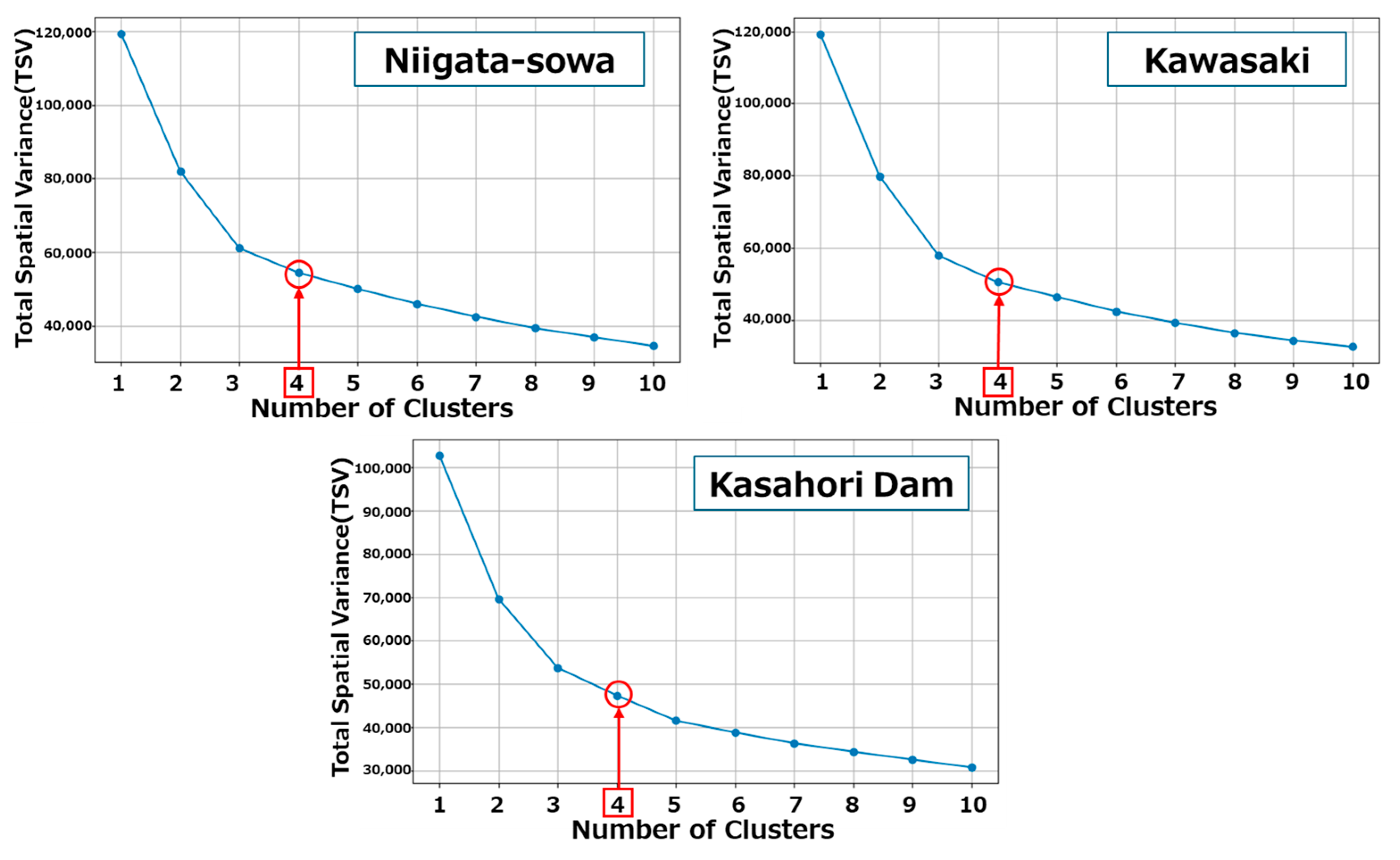
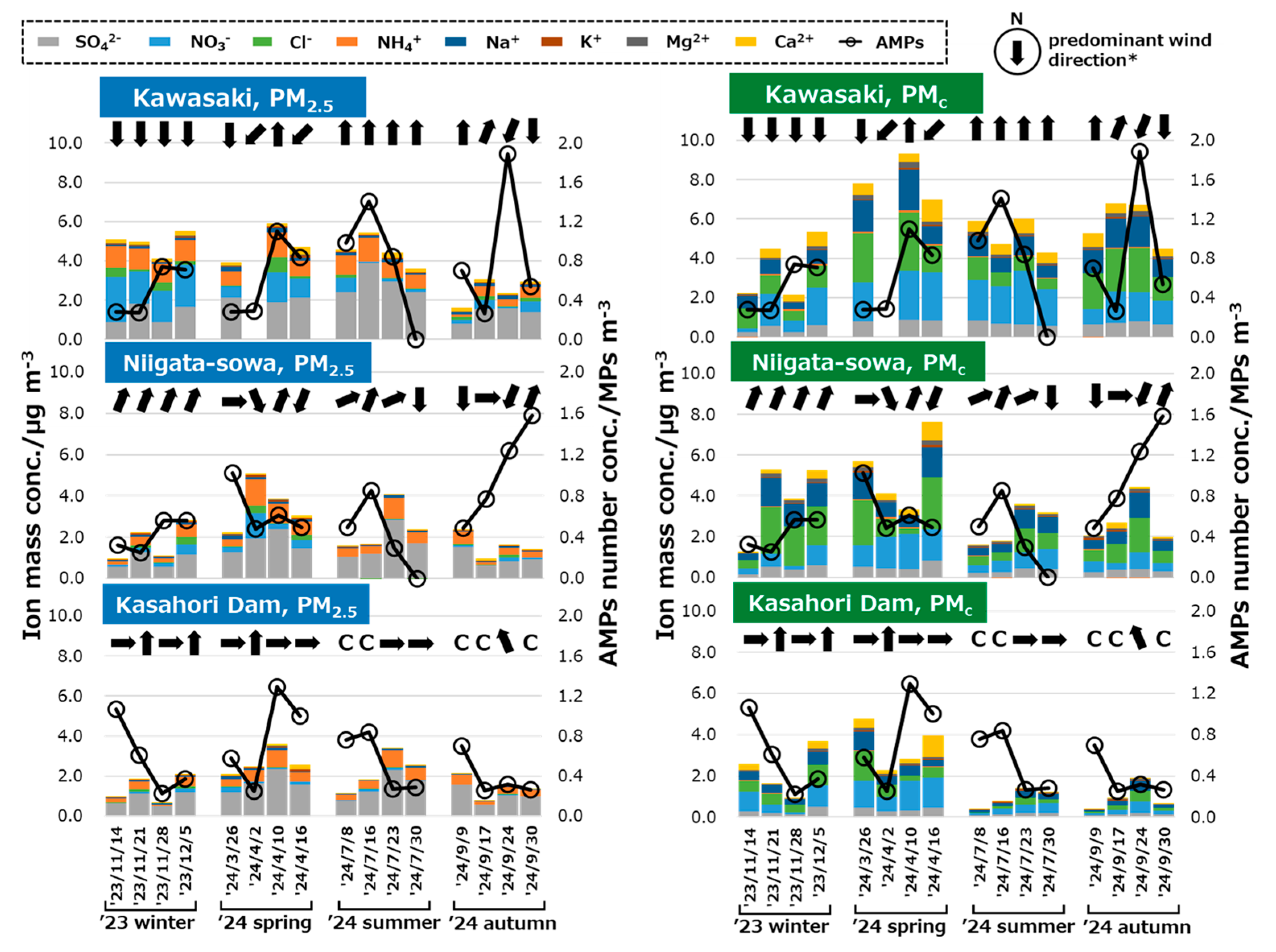
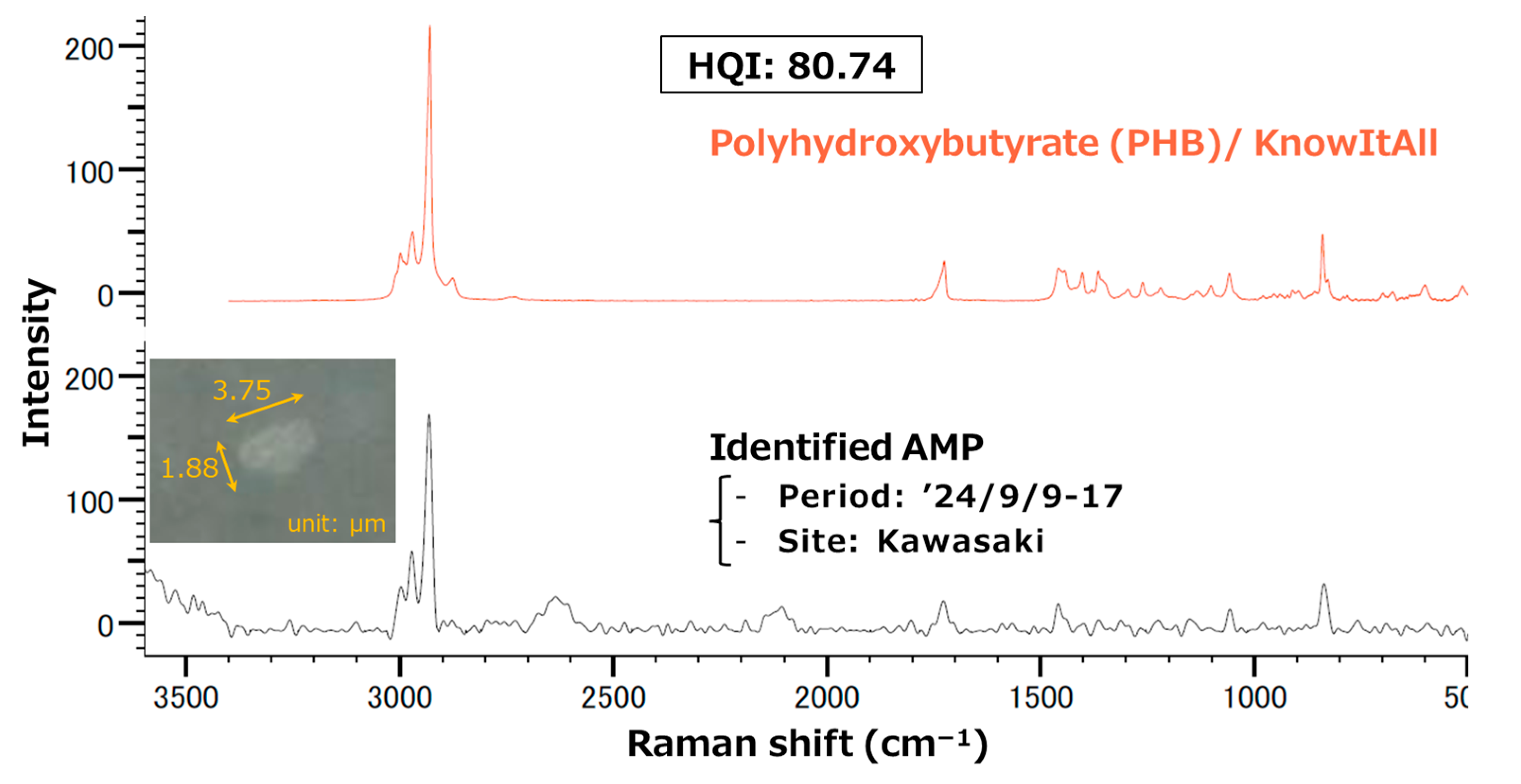
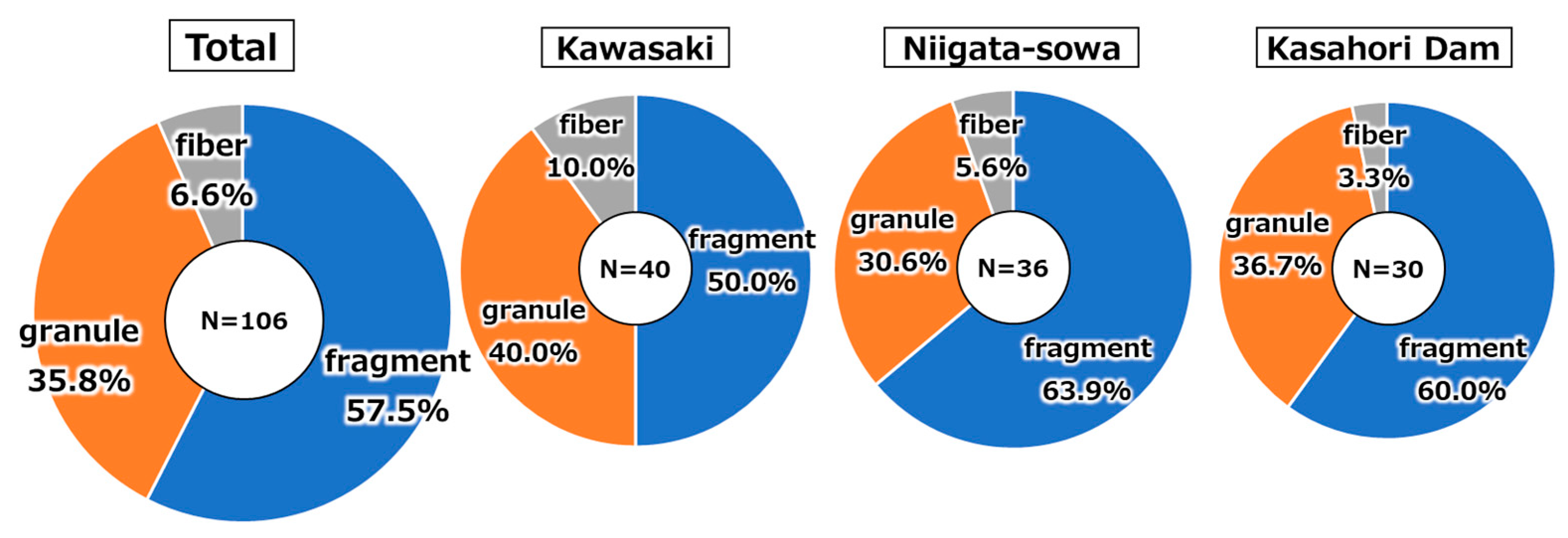
Appendix B
Appendix B.1. Supporting Notes
Appendix B.1.1. Sampling Methods
| Spl. No. | Winter (2023) | Spring (2024) | Summer (2024) | Autumn (2024) | ||||
|---|---|---|---|---|---|---|---|---|
| Period | Days | Period | Days | Period | Days | Period | Days | |
| No.1 | 14 NOV−21 NOV | 7 | 26 MAR−2 APR | 7 | 8 JUL−16 JUL | 8 | 9 SEP−17 SEP | 8 |
| No.2 | 21 NOV−28 NOV | 7 | 2 APR−10 APR | 8 | 16 JUL−23 JUL | 7 | 17 SEP−24 SEP | 7 |
| No.3 | 28 NOV−5 DEC | 7 | 10 APR−16 APR | 6 | 23 JUL−30 JUL | 7 | 24 SEP−30 SEP | 6 |
| No.4 | 5 DEC−12 DEC | 7 | 16 APR−23 APR | 7 | 30 JUL−6 AUG | 7 | 30 SEP−7 OCT | 7 |
Appendix B.1.2. Preparation for AMPs Samples
Appendix B.1.3. Identification of AMPs
Appendix B.1.4. PM Sample Preparation and Analysis
References
- World Economic Forum. The New Plastics Economy: Rethinking the Future of Plastics. Available online: https://jp.weforum.org/publications/the-new-plastics-economy-rethinking-the-future-of-plastics/ (accessed on 9 May 2025).
- Hartmann, N.B.; Hüffer, T.; Thompson, R.C.; Hassellöv, M.; Verschoor, A.; Daugaard, A.E.; Rist, S.; Karlsson, T.; Brennholt, N.; Cole, M.; et al. Are We Speaking the Same Language? Recommendations for a Definition and Categorization Framework for Plastic Debris. Environ. Sci. Technol. 2019, 53, 1039–1047. [Google Scholar] [CrossRef] [PubMed]
- Eriksen, M.; Lebreton, L.C.M.; Carson, H.S.; Thiel, M.; Moore, C.J.; Borerro, J.C.; Galgani, F.; Ryan, P.G.; Reisser, J. Plastic Pollution in the World’s Oceans: More than 5 Trillion Plastic Pieces Weighing over 250,000 Tons Afloat at Sea. PLoS ONE 2014, 9, e111913. [Google Scholar] [CrossRef] [PubMed]
- Zhao, S.; Kvale, K.F.; Zhu, L.; Zettler, E.R.; Egger, M.; Mincer, T.J.; Amaral-Zettler, L.A.; Lebreton, L.; Niemann, H.; Nakajima, R.; et al. The Distribution of Subsurface Microplastics in the Ocean. Nature 2025, 641, 51–61. [Google Scholar] [CrossRef] [PubMed]
- Kameda, Y.; Yamada, N.; Fujita, E. Source- and Polymer-Specific Size Distributions of Fine Microplastics in Surface Water in an Urban River. Environ. Pollut. 2021, 284, 117516. [Google Scholar] [CrossRef]
- Nihei, Y.; Yoshida, T.; Kataoka, T.; Ogata, R. High-Resolution Mapping of Japanese Microplastic and Macroplastic Emissions from the Land into the Sea. Water 2020, 12, 951. [Google Scholar] [CrossRef]
- Free, C.M.; Jensen, O.P.; Mason, S.A.; Eriksen, M.; Williamson, N.J.; Boldgiv, B. High-Levels of Microplastic Pollution in a Large, Remote, Mountain Lake. Mar. Pollut. Bull. 2014, 85, 156–163. [Google Scholar] [CrossRef]
- Scheurer, M.; Bigalke, M. Microplastics in Swiss Floodplain Soils. Environ. Sci. Technol. 2018, 52, 3591–3598. [Google Scholar] [CrossRef]
- Zhou, Y.; Wang, J.; Zou, M.; Yin, Q.; Qiu, Y.; Li, C.; Ye, B.; Guo, T.; Jia, Z.; Li, Y.; et al. Microplastics in Urban Soils of Nanjing in Eastern China: Occurrence, Relationships, and Sources. Chemosphere 2022, 303, 134999. [Google Scholar] [CrossRef]
- Sunaga, N.; Okochi, H.; Niida, Y.; Miyazaki, A. Alkaline Extraction Yields a Higher Number of Microplastics in Forest Canopy Leaves: Implication for Microplastic Storage. Environ. Chem. Lett. 2024, 22, 1599–1606. [Google Scholar] [CrossRef]
- Tokunaga, Y.; Okochi, H.; Tani, Y.; Niida, Y.; Tachibana, T.; Saigawa, K.; Katayama, K.; Moriguchi, S.; Kato, T.; Hayama, S. Airborne Microplastics Detected in the Lungs of Wild Birds in Japan. Chemosphere 2023, 321, 138032. [Google Scholar] [CrossRef]
- Dris, R.; Gasperi, J.; Mirande, C.; Mandin, C.; Guerrouache, M.; Langlois, V.; Tassin, B. A First Overview of Textile Fibers, Including Microplastics, in Indoor and Outdoor Environments. Environ. Pollut. 2017, 221, 453–458. [Google Scholar] [CrossRef] [PubMed]
- Allen, S.; Allen, D.; Phoenix, V.R.; Le Roux, G.; Durántez Jiménez, P.; Simonneau, A.; Binet, S.; Galop, D. Atmospheric Transport and Deposition of Microplastics in a Remote Mountain Catchment. Nat. Geosci. 2019, 12, 339–344. [Google Scholar] [CrossRef]
- Allen, S.; Allen, D.; Moss, K.; Le Roux, G.; Phoenix, V.R.; Sonke, J.E. Examination of the Ocean as a Source for Atmospheric Microplastics. PLoS ONE 2020, 15, e0232746. [Google Scholar] [CrossRef] [PubMed]
- Allen, S.; Allen, D.; Baladima, F.; Phoenix, V.R.; Thomas, J.L.; Le Roux, G.; Sonke, J.E. Evidence of Free Tropospheric and Long-Range Transport of Microplastic at Pic Du Midi Observatory. Nat. Commun. 2021, 12, 7242. [Google Scholar] [CrossRef]
- Wang, Y.; Okochi, H.; Tani, Y.; Hayami, H.; Minami, Y.; Katsumi, N.; Takeuchi, M.; Sorimachi, A.; Fujii, Y.; Kajino, M.; et al. Airborne Hydrophilic Microplastics in Cloud Water at High Altitudes and Their Role in Cloud Formation. Environ. Chem. Lett. 2023, 21, 3055–3062. [Google Scholar] [CrossRef]
- Sasaki, H.; Takahashi, T.; Futami, M.; Endo, T.; Hirano, M.; Kotake, Y. A Trial Survey on Atmospheric/Airborne Microplastics Using Micro-Raman Spectroscopy (μRaman). J. Environ. Chem. 2024, 34, 61–70. (In Japanese) [Google Scholar] [CrossRef]
- Amato-Lourenço, L.F.; Carvalho-Oliveira, R.; Júnior, G.R.; Dos Santos Galvão, L.; Ando, R.A.; Mauad, T. Presence of Airborne Microplastics in Human Lung Tissue. J. Hazard. Mater. 2021, 416, 126124. [Google Scholar] [CrossRef]
- Jenner, L.C.; Rotchell, J.M.; Bennett, R.T.; Cowen, M.; Tentzeris, V.; Sadofsky, L.R. Detection of Microplastics in Human Lung Tissue Using μFTIR Spectroscopy. Sci. Total Environ. 2022, 831, 154907. [Google Scholar] [CrossRef]
- Ragusa, A.; Notarstefano, V.; Svelato, A.; Belloni, A.; Gioacchini, G.; Blondeel, C.; Zucchelli, E.; De Luca, C.; D’Avino, S.; Gulotta, A.; et al. Raman Microspectroscopy Detection and Characterisation of Microplastics in Human Breastmilk. Polymers 2022, 14, 2700. [Google Scholar] [CrossRef]
- Ragusa, A.; Svelato, A.; Santacroce, C.; Catalano, P.; Notarstefano, V.; Carnevali, O.; Papa, F.; Rongioletti, M.C.A.; Baiocco, F.; Draghi, S.; et al. Plasticenta: First Evidence of Microplastics in Human Placenta. Environ. Int. 2021, 146, 106274. [Google Scholar] [CrossRef]
- Leonard, S.V.L.; Liddle, C.R.; Atherall, C.A.; Chapman, E.; Watkins, M.; Calaminus, S.D.J.; Rotchell, J.M. Microplastics in Human Blood: Polymer Types, Concentrations and Characterisation Using μFTIR. Environ. Int. 2024, 188, 108751. [Google Scholar] [CrossRef] [PubMed]
- Vethaak, A.D.; Legler, J. Microplastics and Human Health. Science 2021, 371, 672–674. [Google Scholar] [CrossRef] [PubMed]
- Dris, R.; Gasperi, J.; Saad, M.; Mirande, C.; Tassin, B. Synthetic Fibers in Atmospheric Fallout: A Source of Microplastics in the Environment? Mar. Pollut. Bull. 2016, 104, 290–293. [Google Scholar] [CrossRef] [PubMed]
- Liu, C.; Li, J.; Zhang, Y.; Wang, L.; Deng, J.; Gao, Y.; Yu, L.; Zhang, J.; Sun, H. Widespread Distribution of PET and PC Microplastics in Dust in Urban China and Their Estimated Human Exposure. Environ. Int. 2019, 128, 116–124. [Google Scholar] [CrossRef]
- Syafei, A.D.; Nurasrin, N.R.; Assomadi, A.F.; Boedisantoso, R. Microplastic Pollution in the Ambient Air of Surabaya, Indonesia. Curr. World Environ. 2019, 14, 290–298. [Google Scholar] [CrossRef]
- Wright, S.L.; Ulke, J.; Font, A.; Chan, K.L.A.; Kelly, F.J. Atmospheric Microplastic Deposition in an Urban Environment and an Evaluation of Transport. Environ. Int. 2020, 136, 105411. [Google Scholar] [CrossRef]
- Abbasi, S.; Keshavarzi, B.; Moore, F.; Turner, A.; Kelly, F.J.; Dominguez, A.O.; Jaafarzadeh, N. Distribution and Potential Health Impacts of Microplastics and Microrubbers in Air and Street Dusts from Asaluyeh County, Iran. Environ. Pollut. 2019, 244, 153–164. [Google Scholar] [CrossRef]
- Aves, A.; Ruffell, H.; Evangeliou, N.; Gaw, S.; Revell, L.E. Modelled Sources of Airborne Microplastics Collected at a Remote Southern Hemisphere Site. Atmos. Environ. 2024, 325, 120437. [Google Scholar] [CrossRef]
- Sridharan, S.; Kumar, M.; Singh, L.; Bolan, N.S.; Saha, M. Microplastics as an Emerging Source of Particulate Air Pollution: A Critical Review. J. Hazard. Mater. 2021, 418, 126245. [Google Scholar] [CrossRef]
- Chen, G.; Feng, Q.; Wang, J. Mini-Review of Microplastics in the Atmosphere and Their Risks to Humans. Sci. Total Environ. 2020, 703, 135504. [Google Scholar] [CrossRef]
- WHO Global Air Quality Guidelines: Particulate Matter (PM2.5 and PM10), Ozone, Nitrogen Dioxide, Sulfur Dioxide and Carbon Monoxide, 1st ed.; World Health Organization: Geneva, Switzerland, 2021; ISBN 978-92-4-003422-8.
- Revell, L.E.; Kuma, P.; Le Ru, E.C.; Somerville, W.R.C.; Gaw, S. Direct Radiative Effects of Airborne Microplastics. Nature 2021, 598, 462–467. [Google Scholar] [CrossRef] [PubMed]
- Kabir, M.S.; Wang, H.; Luster-Teasley, S.; Zhang, L.; Zhao, R. Microplastics in Landfill Leachate: Sources, Detection, Occurrence, and Removal. Environ. Sci. Ecotechnol. 2023, 16, 100256. [Google Scholar] [CrossRef] [PubMed]
- Katsumi, N.; Kusube, T.; Nagao, S.; Okochi, H. Spatiotemporal Variation in Microplastics Derived from Polymer-Coated Fertilizer in an Agricultural Small River in Ishikawa Prefecture, Japan. Environ. Pollut. 2023, 325, 121422. [Google Scholar] [CrossRef] [PubMed]
- Suzuki, G.; Uchida, N.; Tanaka, K.; Higashi, O.; Takahashi, Y.; Kuramochi, H.; Yamaguchi, N.; Osako, M. Global Discharge of Microplastics from Mechanical Recycling of Plastic Waste. Environ. Pollut. 2024, 348, 123855. [Google Scholar] [CrossRef]
- Brahney, J.; Mahowald, N.; Prank, M.; Cornwell, G.; Klimont, Z.; Matsui, H.; Prather, K.A. Constraining the Atmospheric Limb of the Plastic Cycle. Proc. Natl. Acad. Sci. USA 2021, 118, e2020719118. [Google Scholar] [CrossRef]
- Akhbarizadeh, R.; Dobaradaran, S.; Amouei Torkmahalleh, M.; Saeedi, R.; Aibaghi, R.; Faraji Ghasemi, F. Suspended Fine Particulate Matter (PM2.5), Microplastics (MPs), and Polycyclic Aromatic Hydrocarbons (PAHs) in Air: Their Possible Relationships and Health Implications. Environ. Res. 2021, 192, 110339. [Google Scholar] [CrossRef]
- Kirchsteiger, B.; Materić, D.; Happenhofer, F.; Holzinger, R.; Kasper-Giebl, A. Fine Micro- and Nanoplastics Particles (PM2.5) in Urban Air and Their Relation to Polycyclic Aromatic Hydrocarbons. Atmos. Environ. 2023, 301, 119670. [Google Scholar] [CrossRef]
- Network Center for EANET. Technical Manual for Air Concentration Monitoring in East Asia. Available online: https://www.eanet.asia/wp-content/uploads/2019/04/techacm.pdf (accessed on 21 May 2025).
- Mason, R.P. Trace Metals in Aquatic Systems; John Wiley & Sons: Hoboken, NJ, USA, 2013; ISBN 978-1-118-27457-6. [Google Scholar]
- Warneck, P. Chemistry of the Natural Atmosphere, 2nd ed.; This is Volume 71 in the International Geophysics Series; Academic Press: San Diego, CA, USA, 2000; ISBN 978-0-12-735632-7. [Google Scholar]
- Chow, W.S.; Liao, K.; Huang, X.H.H.; Leung, K.F.; Lau, A.K.H.; Yu, J.Z. Measurement Report: The 10-Year Trend of PM2.5 Major Components and Source Tracers from 2008 to 2017 in an Urban Site of Hong Kong, China. Atmos. Chem. Phys. 2022, 22, 11557–11577. [Google Scholar] [CrossRef]
- Fakhri, N.; Fadel, M.; Pikridas, M.; Sciare, J.; Hayes, P.L.; Afif, C. Source Apportionment of PM2.5 Using Organic/Inorganic Markers and Emission Inventory Evaluation in the East Mediterranean-Middle East City of Beirut. Environ. Res. 2023, 223, 115446. [Google Scholar] [CrossRef]
- Tian, Y.; Wang, X.; Zhao, P.; Shi, Z.; Harrison, R.M. PM2.5 Source Apportionment Using Organic Marker-Based Chemical Mass Balance Modeling: Influence of Inorganic Markers and Sensitivity to Source Profiles. Atmos. Environ. 2023, 294, 119477. [Google Scholar] [CrossRef]
- Liu, K.; Wang, X.; Wei, N.; Song, Z.; Li, D. Accurate Quantification and Transport Estimation of Suspended Atmospheric Microplastics in Megacities: Implications for Human Health. Environ. Int. 2019, 132, 105127. [Google Scholar] [CrossRef] [PubMed]
- Hurley, R.R.; Lusher, A.L.; Olsen, M.; Nizzetto, L. Validation of a Method for Extracting Microplastics from Complex, Organic-Rich, Environmental Matrices. Environ. Sci. Technol. 2018, 52, 7409–7417. [Google Scholar] [CrossRef] [PubMed]
- Käppler, A.; Windrich, F.; Löder, M.G.J.; Malanin, M.; Fischer, D.; Labrenz, M.; Eichhorn, K.-J.; Voit, B. Identification of Microplastics by FTIR and Raman Microscopy: A Novel Silicon Filter Substrate Opens the Important Spectral Range below 1300 cm−1 for FTIR Transmission Measurements. Anal. Bioanal. Chem. 2015, 407, 6791–6801. [Google Scholar] [CrossRef] [PubMed]
- Araujo, C.F.; Nolasco, M.M.; Ribeiro, A.M.P.; Ribeiro-Claro, P.J.A. Identification of Microplastics Using Raman Spectroscopy: Latest Developments and Future Prospects. Water Res. 2018, 142, 426–440. [Google Scholar] [CrossRef] [PubMed]
- Harusato, A.; Kato, M. Mechanisms of Generation and Ecological Impacts of Nano- and Microplastics from Artificial Turf Systems in Sports Facilities. Environments 2025, 12, 109. [Google Scholar] [CrossRef]
- Azari, A.; Ronsmans, S.; Vanoirbeek, J.A.J.; Hoet, P.H.M.; Ghosh, M. Challenges in Raman Spectroscopy of (Micro)Plastics: The Interfering Role of Colourants. Environ. Pollut. 2024, 363, 125250. [Google Scholar] [CrossRef]
- Dąbrowska, A.; Mielańczuk, M.; Syczewski, M. The Raman Spectroscopy and SEM/EDS Investigation of the Primary Sources of Microplastics from Cosmetics Available in Poland. Chemosphere 2022, 308, 136407. [Google Scholar] [CrossRef]
- World Health Organization. Determination of Airborne Fibre Number Concentrations: A Recommended Method, by Phase-Contrast Optical Microscopy (Membrane Filter Method); World Health Organization: Geneva, Switzerland, 1997; ISBN 978-92-4-154496-2. [Google Scholar]
- Li, Y.; Shao, L.; Wang, W.; Zhang, M.; Feng, X.; Li, W.; Zhang, D. Airborne Fiber Particles: Types, Size and Concentration Observed in Beijing. Sci. Total Environ. 2020, 705, 135967. [Google Scholar] [CrossRef]
- Ministry of the Environment, Japan. A Manual for the Measurement of Atmospheric Fine Particulate Matter (PM2.5) Components. Available online: https://www.env.go.jp/air/osen/pm/ca/manual.html (accessed on 27 May 2025). (In Japanese)
- Takahashi, T.; Take, N.; Ohizumi, T.; Morohashi, M.; Takahashi, M.; Sase, H. Source Estimation of PM2.5 Observed from 2016 to 2017 in Niigata City Using Organic Marker Components. J. Jpn. Soc. Atmos. Env. 2020, 55, 60–77. (In Japanese) [Google Scholar] [CrossRef]
- Taniguchi, Y.; Shimada, K.; Takami, A.; Lin, N.-H.; Chan, C.K.; Kim, Y.P.; Hatakeyama, S. Transboundary and Local Air Pollutants in Western Japan Distinguished on the Basis of Ratios of Metallic Elements in Size-Segregated Aerosols. Aerosol Air Qual. Res. 2017, 17, 3141–3150. [Google Scholar] [CrossRef]
- Sasaki, H.; Endo, T.; Sato, S.; Take, N.; Mitobe, H.; Yagoh, H. Evaluation of PM2.5 Impactor-Fitted Filter-Pack Method for Dry Deposition Monitoring. J. Jpn. Soc. Atmos. Environ. 2022, 57, 66–76. (In Japanese) [Google Scholar] [CrossRef]
- Japan Meteorological Agency. Downloads: The Past Meteorological Data. Available online: https://www.data.jma.go.jp/risk/obsdl/index.php (accessed on 10 June 2025). (In Japanese)
- National Institute for Environmental Studies, Japan. Global Environmental Database, Trajectory (METEX). Available online: https://db.cger.nies.go.jp/ged/metex/en/index.html (accessed on 13 May 2025).
- Saha, S.; Moorthi, S.; Wu, X.; Wang, J.; Nadiga, S.; Tripp, P.; Behringer, D.; Hou, Y.-T.; Chuang, H.; Iredell, M.; et al. NCEP Climate Forecast System Version 2 (CFSv2) 6-Hourly Products 2011; National Science Foundation: Ann Arbor, MI, USA; National Center for Atmospheric Research (NCAR): Boulder, CO, USA, 2011.
- Sirois, A.; Bottenheim, J.W. Use of Backward Trajectories to Interpret the 5-Year Record of PAN and O3 Ambient Air Concentrations at Kejimkujik National Park, Nova Scotia. J. Geophys. Res. Atmos. 1995, 100, 2867–2881. [Google Scholar] [CrossRef]
- Liu, N.; Yu, Y.; He, J.; Zhao, S. Integrated Modeling of Urban–Scale Pollutant Transport: Application in a Semi–Arid Urban Valley, Northwestern China. Atmos. Pollut. Res. 2013, 4, 306–314. [Google Scholar] [CrossRef]
- Ali-Mohamed, A.Y.; Maki, K.E.; Saeed, A.A.A.; Abdulla, A.M.; Abdulla, M.I. Estimation of Inorganic Particulate Matter in Atmospheres of Villages in Bahrain, by Dry Fall. Atmos. Environ. 1995, 29, 1519–1529. [Google Scholar] [CrossRef]
- Gluščić, V.; Čačković, M.; Pehnec, G.; Bešlić, I. Ionic Composition of PM2.5 Particle Fraction at a Coastal Urban Background Site in Croatia. Atmos. Pollut. Res. 2020, 11, 2202–2214. [Google Scholar] [CrossRef]
- Li, B.; Ma, Y.; Zhou, Y.; Chai, E. Research Progress of Different Components of PM2.5 and Ischemic Stroke. Sci. Rep. 2023, 13, 15965. [Google Scholar] [CrossRef]
- Levermore, J.M.; Smith, T.E.L.; Kelly, F.J.; Wright, S.L. Detection of Microplastics in Ambient Particulate Matter Using Raman Spectral Imaging and Chemometric Analysis. Anal. Chem. 2020, 92, 8732–8740. [Google Scholar] [CrossRef]
- Liu, K.; Wu, T.; Wang, X.; Song, Z.; Zong, C.; Wei, N.; Li, D. Consistent Transport of Terrestrial Microplastics to the Ocean through Atmosphere. Environ. Sci. Technol. 2019, 53, 10612–10619. [Google Scholar] [CrossRef]
- Liu, K.; Wang, X.; Fang, T.; Xu, P.; Zhu, L.; Li, D. Source and Potential Risk Assessment of Suspended Atmospheric Microplastics in Shanghai. Sci. Total Environ. 2019, 675, 462–471. [Google Scholar] [CrossRef]
- Gaston, E.; Woo, M.; Steele, C.; Sukumaran, S.; Anderson, S. Microplastics Differ Between Indoor and Outdoor Air Masses: Insights from Multiple Microscopy Methodologies. Appl. Spectrosc. 2020, 74, 1079–1098. [Google Scholar] [CrossRef]
- Japan Meteorological Agency. Information on Dust and Sandstorms (DSS). Available online: https://www.data.jma.go.jp/env/kosa/fcst/ (accessed on 26 April 2024). (In Japanese)
- Shimada, K.; Yang, X.; Araki, Y.; Yoshino, A.; Takami, A.; Chen, X.; Meng, F.; Hatakeyama, S. Concentrations of Metallic Elements in Long-Range-Transported Aerosols Measured Simultaneously at Three Coastal Sites in China and Japan. J. Atmos. Chem. 2018, 75, 123–139. [Google Scholar] [CrossRef]
- Rao, K.N.; Abdullah, A. Aspen HYSYS Simulation of Suspension (Slurry) Process for the Production of Polyethylene. J. Polym. Compos. 2018, 6, 31. [Google Scholar]
- Mufarrij, F.; Ashrafi, O.; Navarri, P.; Khojasteh, Y. Development and Lifecycle Assessment of Various Low- and High-Density Polyethylene Production Processes Based on CO2 Capture and Utilization. J. Clean. Prod. 2023, 414, 137624. [Google Scholar] [CrossRef]
- Plastic Waste Management Institute. An Introduction to Plastic Recycling in Japan. Available online: https://www.pwmi.or.jp/english/ (accessed on 25 July 2025).
- Lv, H.; Park, J.; Lim, H.K.; Abraham, I.J.; Yin, X.; Gao, Y.; Hur, J. Impacts of Polyhydroxybutyrate (PHB) Microplastic Exposure on Physiology and Metabolic Profiles of Litopenaeus Vannamei. Sci. Total Environ. 2024, 951, 175588. [Google Scholar] [CrossRef]
- Lott, C.; Eich, A.; Makarow, D.; Unger, B.; van Eekert, M.; Schuman, E.; Reinach, M.S.; Lasut, M.T.; Weber, M. Half-Life of Biodegradable Plastics in the Marine Environment Depends on Material, Habitat, and Climate Zone. Front. Mar. Sci. 2021, 8, 662074. [Google Scholar] [CrossRef]
- González-Pleiter, M.; Tamayo-Belda, M.; Pulido-Reyes, G.; Amariei, G.; Leganés, F.; Rosal, R.; Fernández-Piñas, F. Secondary Nanoplastics Released from a Biodegradable Microplastic Severely Impact Freshwater Environments. Environ. Sci. Nano 2019, 6, 1382–1392. [Google Scholar] [CrossRef]
- Jin, F.-L.; Li, X.; Park, S.-J. Synthesis and Application of Epoxy Resins: A Review. J. Ind. Eng. Chem. 2015, 29, 1–11. [Google Scholar] [CrossRef]
- Henderson, A.M. Ethylene-Vinyl Acetate (EVA) Copolymers: A General Review. IEEE Electr. Insul. Mag. 1993, 9, 30–38. [Google Scholar] [CrossRef]
- Lacsado, M.F.Y.; Batawan, J.L.; Apalacio, H.; Sultan, K.H. Utilization of Ethylene-Vinyl Acetate (EVA) Waste from Footwear Industry as Partial Replacement of Aggregates for Concrete Roof Tile. Key Eng. Mater. 2023, 953, 99–104. [Google Scholar] [CrossRef]
- Klein, M.; Fischer, E.K. Microplastic Abundance in Atmospheric Deposition within the Metropolitan Area of Hamburg, Germany. Sci. Total Environ. 2019, 685, 96–103. [Google Scholar] [CrossRef]
- Tarigan, M.Y.; Ebrahimi, M. Separation and Purification of Vanillin and Syringaldehyde from an Oxidized Kraft Liquor—A Mini Review. Chem. Ing. Tech. 2024, 96, 418–431. [Google Scholar] [CrossRef]
- Cao, M.; Li, W.; Ge, P.; Chen, M.; Wang, J. Seasonal Variations and Potential Sources of Biomass Burning Tracers in Particulate Matter in Nanjing Aerosols during 2017–2018. Chemosphere 2022, 303, 135015. [Google Scholar] [CrossRef] [PubMed]
- Kawamura, K.; Pavuluri, C.M. New Directions: Need for Better Understanding of Plastic Waste Burning as Inferred from High Abundance of Terephthalic Acid in South Asian Aerosols. Atmos. Environ. 2010, 44, 5320–5321. [Google Scholar] [CrossRef]
- Wang, X.; Qin, W.; Jiao, F.; Dong, L.; Guo, J.; Zhang, J.; Yang, C. Review of Tungsten Resource Reserves, Tungsten Concentrate Production and Tungsten Beneficiation Technology in China. Trans. Nonferrous Met. Soc. China 2022, 32, 2318–2338. [Google Scholar] [CrossRef]
- Wang, Y.; Nie, B.; Zheng, S.; Wu, H.; Chen, N.; Wang, D. Emerging Activated Tungsten Dust: Source, Environmental Behaviors, and Health Effects. Environ. Int. 2024, 188, 108774. [Google Scholar] [CrossRef]
- Chen, P.-W.; Hsiao, M.-N.; Xiao, L.-W.; Liu, Z.-S. Adsorption Behavior of Heavy Metals onto Microplastics Derived from Conventional and Biodegradable Commercial Plastic Products. Sci. Total Environ. 2024, 951, 175537. [Google Scholar] [CrossRef]
- Tang, S.; Lin, L.; Wang, X.; Yu, A.; Sun, X. Interfacial Interactions between Collected Nylon Microplastics and Three Divalent Metal Ions (Cu(II), Ni(II), Zn(II)) in Aqueous Solutions. J. Hazard. Mater. 2021, 403, 123548. [Google Scholar] [CrossRef]
- Martínez Morales, S.; Cerón Bretón, J.G.; Carbajal, N.; Cerón Bretón, R.M.; Lara Severino, R.; Kahl, J.D.W.; Carrillo Ávila, J.R.; Carranco Lozada, S.E.; Espinosa Guzmán, A.; Pech Pech, I.E.; et al. PM2.5-Bound Trace Metals in an Urban Area of Northern Mexico during the COVID-19 Pandemic: Characterization, Sources, and Health Risk. Air Qual. Atmos. Health 2023, 16, 1789–1808. [Google Scholar] [CrossRef]
- Maciejczyk, P.; Chen, L.-C.; Thurston, G. The Role of Fossil Fuel Combustion Metals in PM2.5 Air Pollution Health Associations. Atmosphere 2021, 12, 1086. [Google Scholar] [CrossRef]
- Occupational Safety and Health Administration, U.S. Department of Labor. Hexavalent Chromium—Overview. Available online: https://www.osha.gov/hexavalent-chromium (accessed on 25 August 2025).
- Filella, M.; Turner, A. Observational Study Unveils the Extensive Presence of Hazardous Elements in Beached Plastics from Lake Geneva. Front. Environ. Sci. 2018, 6, 1. [Google Scholar] [CrossRef]
- Klöckner, P.; Reemtsma, T.; Wagner, S. The Diverse Metal Composition of Plastic Items and Its Implications. Sci. Total Environ. 2021, 764, 142870. [Google Scholar] [CrossRef]
- Lee, H.-J.; Lee, H.-W.; Park, S.-W.; Jeon, J.-W.; Kim, P.-R.; Kwak, K.-H.; Han, Y.-J.; Holsen, T.M.; Lee, S.-H.; Jung, H.-G.; et al. Characteristics of Elevated PM2.5 Events Driven by Enhanced Organic Compound Concentrations in a South Korean Residential City. Atmos. Environ. 2025, 345, 121053. [Google Scholar] [CrossRef]
- Zhang, Y.Y.; Müller, L.; Winterhalter, R.; Moortgat, G.K.; Hoffmann, T.; Pöschl, U. Seasonal Cycle and Temperature Dependence of Pinene Oxidation Products, Dicarboxylic Acids and Nitrophenols in Fine and Coarse Air Particulate Matter. Atmos. Chem. Phys. 2010, 10, 7859–7873. [Google Scholar] [CrossRef]
- Ikemori, F.; Yamagami, M.; Sugata, S. Impact on Absorption of Gaseous Organic Tracer Compounds in PM2.5 Collected on Quartz Filter. J. Jpn. Soc. Atmos. Environ. 2018, 53, 70–78. (In Japanese) [Google Scholar] [CrossRef]
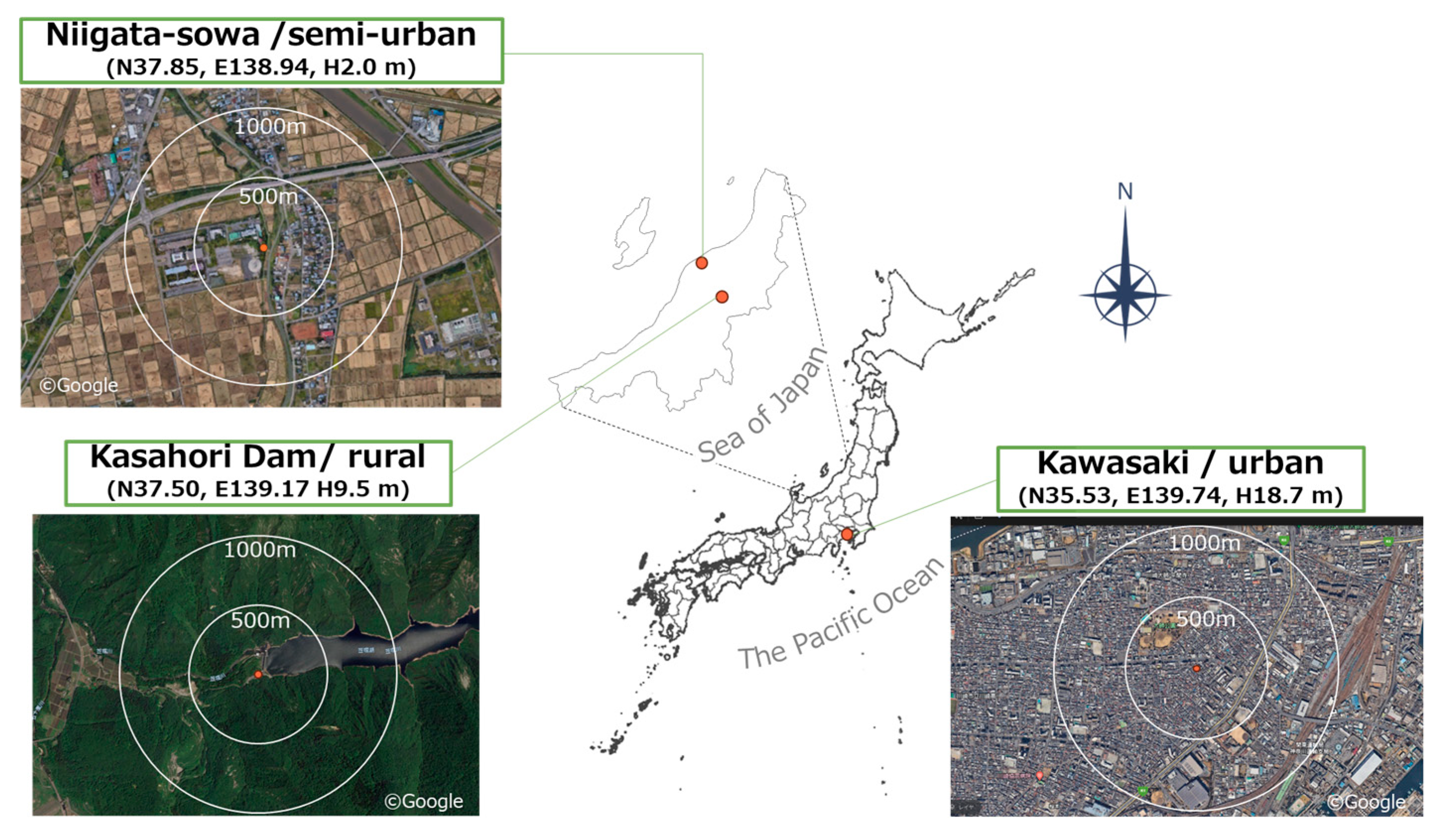
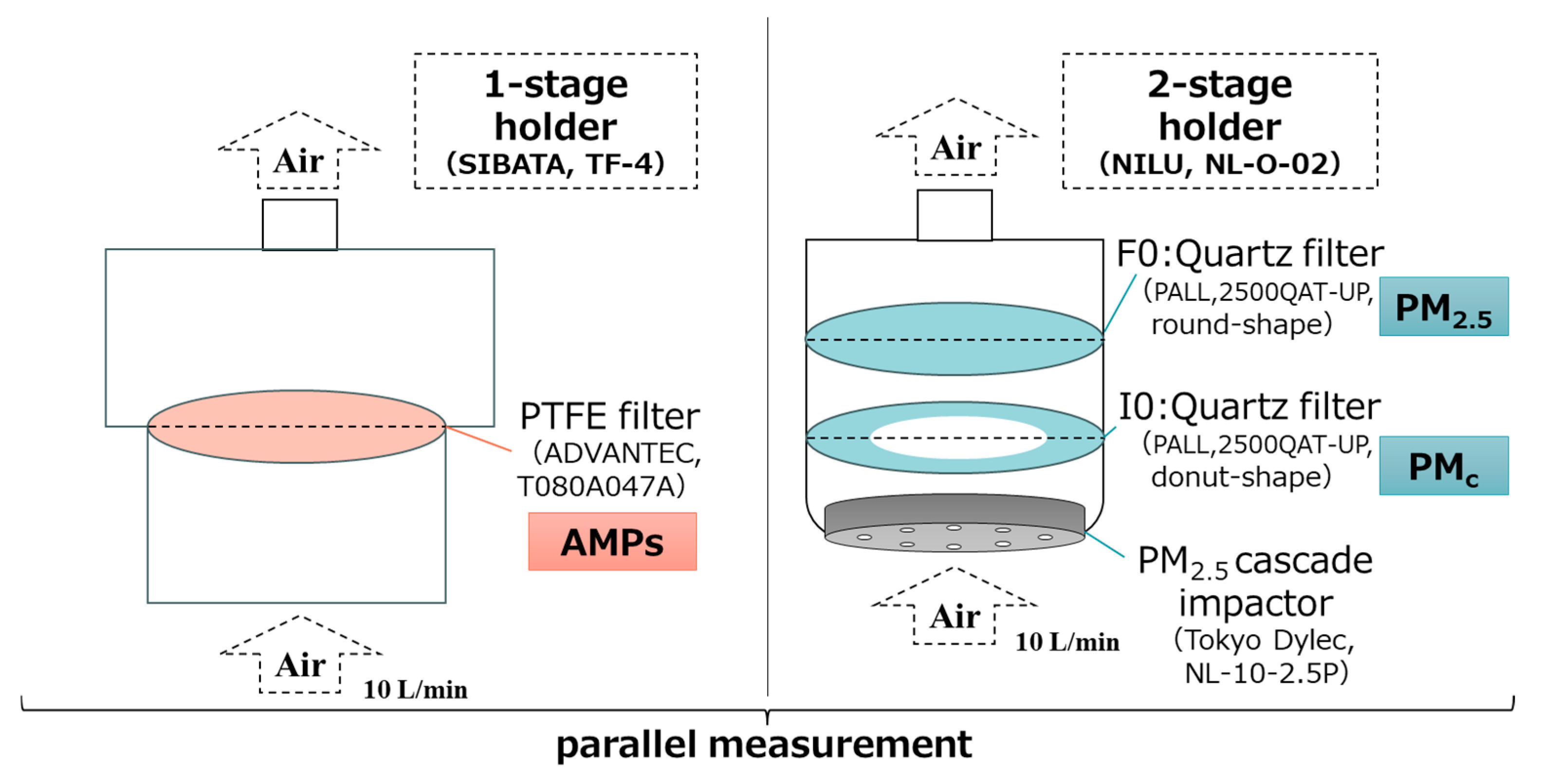
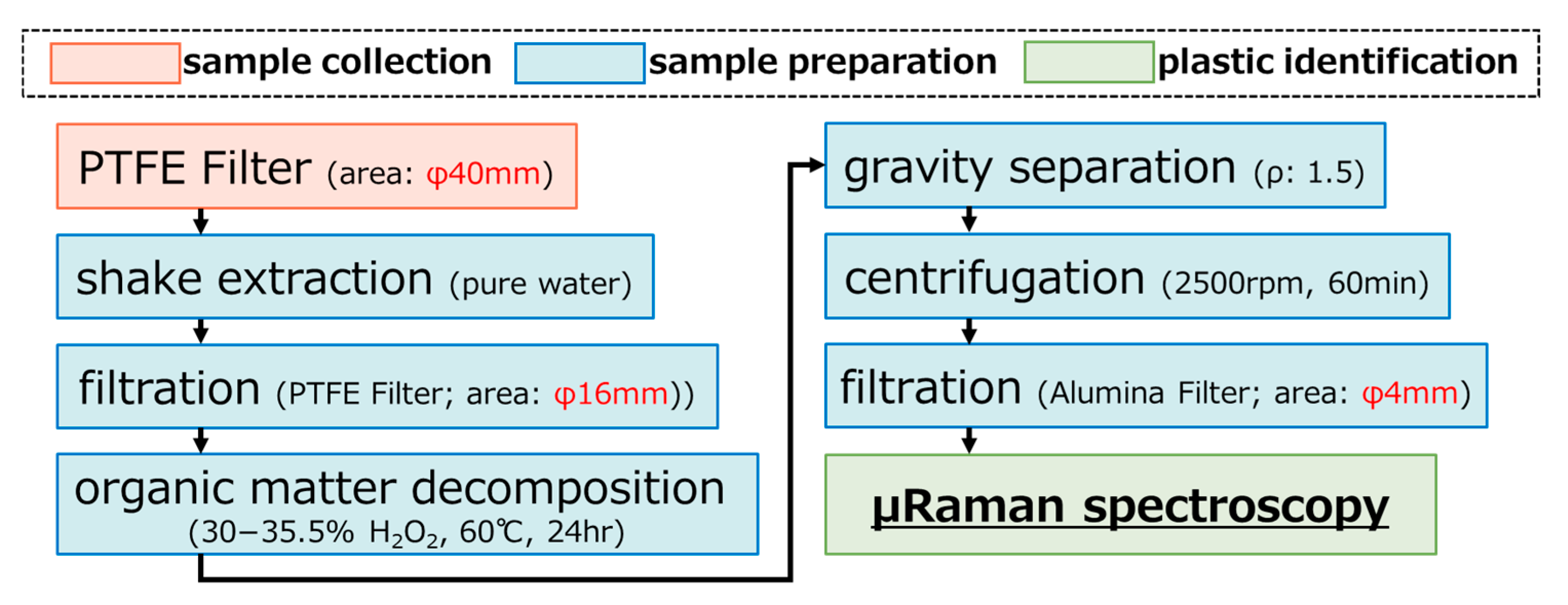
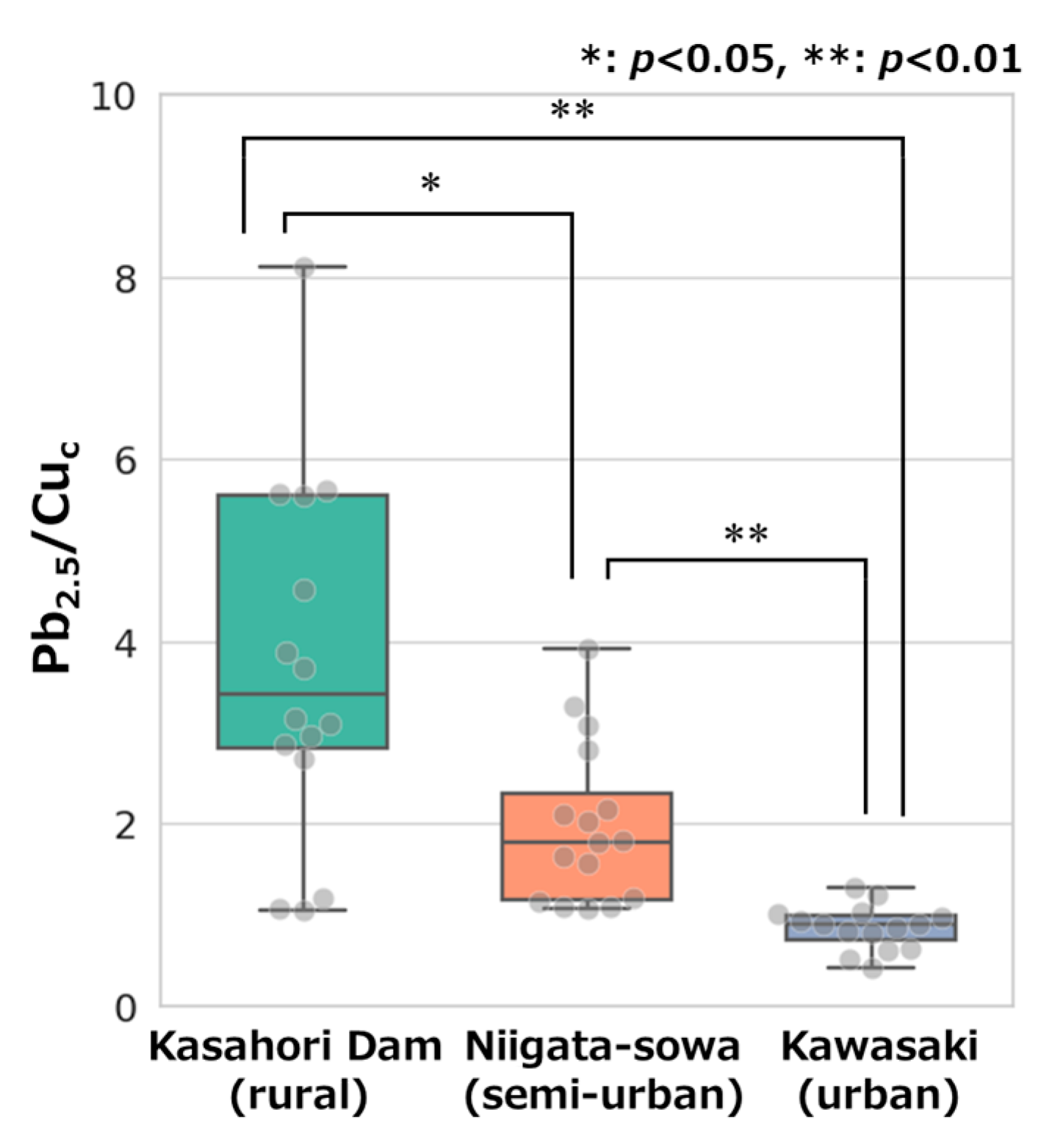

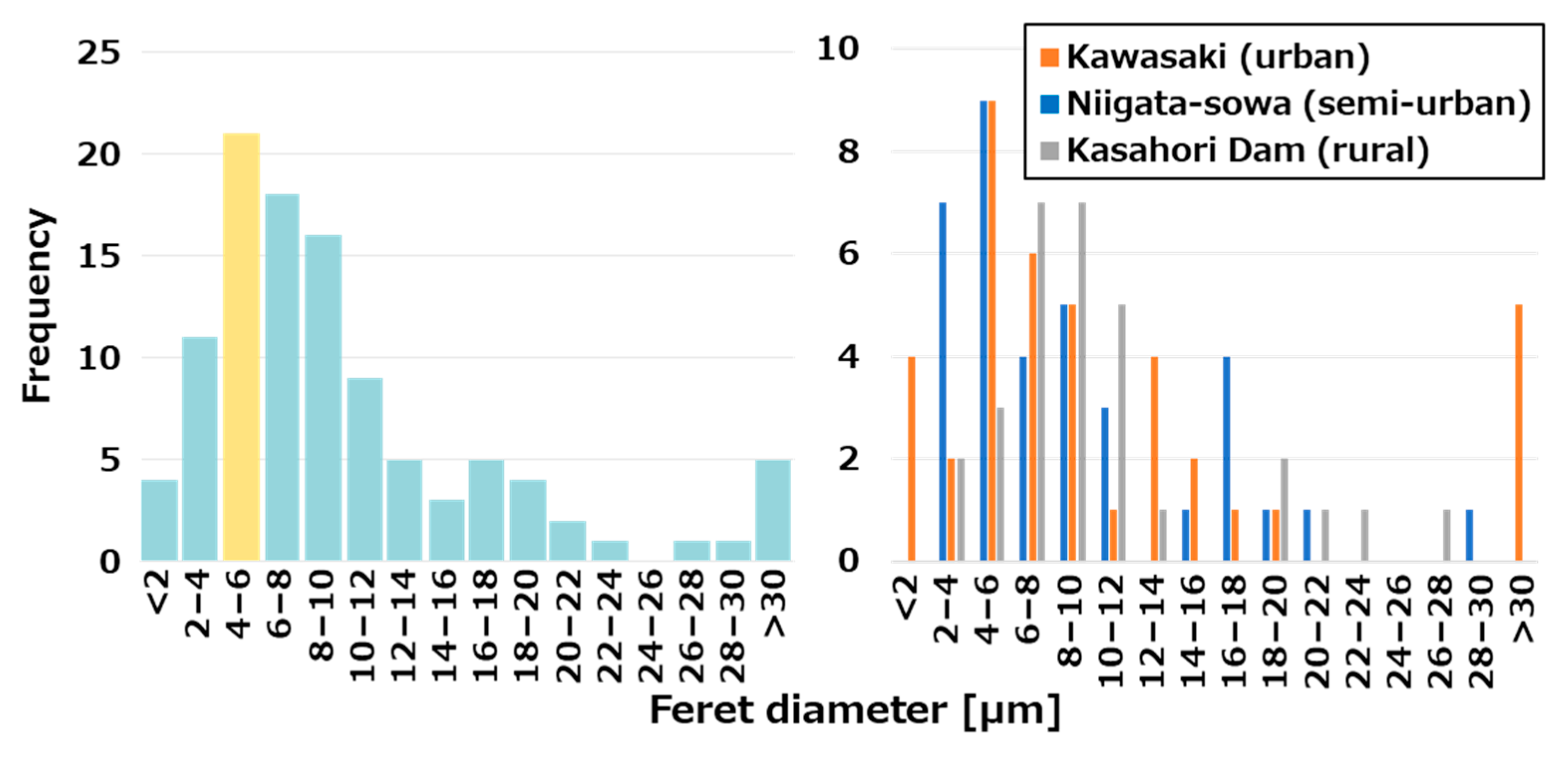

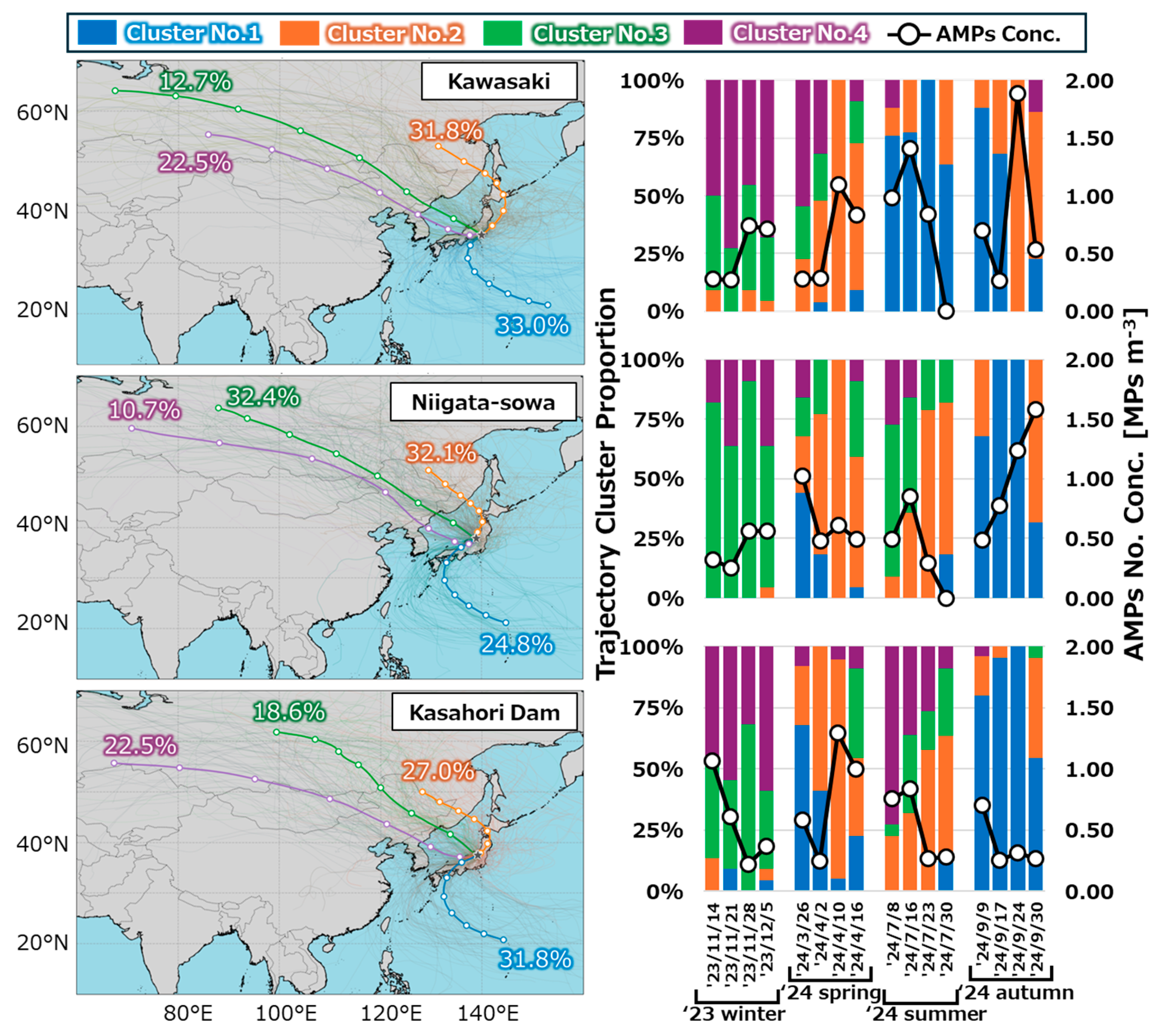
| Site/Attribute | AMPs No. Conc. [MPs m−3] | PM2.5 Total Ion Conc. [µg m−3] | PMc Total Ion Conc. [µg m−3] |
|---|---|---|---|
| Kasahori Dam/rural | 0.57 ± 0.34 | 1.93 ± 0.86 | 1.91 ± 1.34 |
| Niigata-sowa/semi-urban | 0.63 ± 0.39 | 2.34 ± 1.20 | 3.61 ± 1.75 |
| Kawasaki/urban | 0.70 ± 0.49 | 4.16 ± 1.24 | 5.51 ± 1.92 |
Disclaimer/Publisher’s Note: The statements, opinions and data contained in all publications are solely those of the individual author(s) and contributor(s) and not of MDPI and/or the editor(s). MDPI and/or the editor(s) disclaim responsibility for any injury to people or property resulting from any ideas, methods, instructions or products referred to in the content. |
© 2025 by the authors. Licensee MDPI, Basel, Switzerland. This article is an open access article distributed under the terms and conditions of the Creative Commons Attribution (CC BY) license (https://creativecommons.org/licenses/by/4.0/).
Share and Cite
Sasaki, H.; Takahashi, T.; Futami, M.; Endo, T.; Hirano, M.; Kotake, Y.; Pham, K.-O. Airborne Microplastics: Source Implications from Particulate Matter Composition. Atmosphere 2025, 16, 1222. https://doi.org/10.3390/atmos16111222
Sasaki H, Takahashi T, Futami M, Endo T, Hirano M, Kotake Y, Pham K-O. Airborne Microplastics: Source Implications from Particulate Matter Composition. Atmosphere. 2025; 16(11):1222. https://doi.org/10.3390/atmos16111222
Chicago/Turabian StyleSasaki, Hiroyuki, Tsukasa Takahashi, Mari Futami, Tomomi Endo, Mizuho Hirano, Yuka Kotake, and Kim-Oanh Pham. 2025. "Airborne Microplastics: Source Implications from Particulate Matter Composition" Atmosphere 16, no. 11: 1222. https://doi.org/10.3390/atmos16111222
APA StyleSasaki, H., Takahashi, T., Futami, M., Endo, T., Hirano, M., Kotake, Y., & Pham, K.-O. (2025). Airborne Microplastics: Source Implications from Particulate Matter Composition. Atmosphere, 16(11), 1222. https://doi.org/10.3390/atmos16111222








